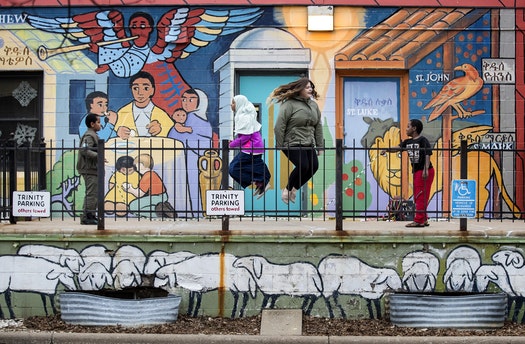|
Source: Star Tribune Date: March 31, 2018 Article by: Jean Hopfensperger Link: Here. Trinity Lutheran Congregation may be the only Minnesota church that commemorates Easter twice each spring — once for its American-born members and another for its East African Orthodox members with a different religious calendar. Trinity stands out for other reasons. It's the only Christian church in a Minneapolis neighborhood known as "Little Mogadishu." It has survived without its own chapel for 50 years. And it has become a civic and spiritual anchor in the Cedar-Riverside community, opening its doors to Christian and Muslim neighbors — including as a temporary home to a mosque. Oh. And it's 150 years old next week.  Senior Pastor Jane Buckley-Farlee spoke before a meal at Trinity Lutheran. Trinity Lutheran is the sole Christian church in Cedar Riverside neighborhood in Minneapolis. PC Carlos Gonzalez, Star Tribune Senior Pastor Jane Buckley-Farlee spoke before a meal at Trinity Lutheran. Trinity Lutheran is the sole Christian church in Cedar Riverside neighborhood in Minneapolis. PC Carlos Gonzalez, Star Tribune "We have an amazing history to celebrate," said Pastor Jane Buckley-Farlee, recalling how the once stern Norwegian Lutheran parish morphed into a multicultural neighborhood center welcoming people of all faiths. "The world is changing, the church is changing," she said. "This is the future." The Rev. Deb Stehlin, a director at the Minneapolis synod of the Evangelical Lutheran Church of America (ELCA), marvels at Trinity's niche and staying power. The Cedar-Riverside area was once home to at least a half-dozen churches, as northern European immigrants poured into the community in the 1800s, she said. Trinity alone remains. "There's no other place in our synod that has that story," Stehlin said. "I think it's pretty remarkable what they're up to. Pastor Jane has been walking those streets for 20 years, building trust relationships with the Muslim and East African communities ... and Pastor Alem [Asmelash] has been a valuable cultural connector." Asmelash came on board part-time a decade ago with an unusual skill set: speaking Amharic and Tigrigna from his birthplace in Ethiopia, Swedish and Norwegian from growing up in Scandinavia — and English. Open up a Trinity church bulletin and see the result. The Lord's Prayer and others are printed in English, Aramaic and Tigrigna. On Sunday, Buckley-Farlee will wish her congregation "Happy Easter" in three languages and encourage church members to do the same. "It's like Pentecost every Sunday with everyone speaking in tongues," joked Asmelash. "Many churches see us as a good role model of multiculturalism. They want to know how we do it." Murals invite neighbors Even without a towering steeple, it's hard to miss Trinity Lutheran on the U's West Bank. The two-story brick building is wrapped in colorful Ethiopian-style murals, inviting neighbors in. Walk inside during a typical week and find about 20 students — mainly Muslim — gathered around tables in its library, writing papers and studying as part of a Safe Place Homework Help program. Students — and parents — say it's been a huge help with schoolwork and after-school care. Fayo Umar, a mother who picked up her daughters there recently, credited the tutors and staff with lifting her children's grades and helping her after a difficult job loss. Said Umar: "I tell parents, 'This is a good place. Take advantage of it.' " Head downstairs on Wednesday nights and find a room full of folks eating a free meal donated by Fairview Hospital or Trinity's partner churches. On a recent night, they dined on rice, turkey and fresh vegetables. The crowd included a mix of Trinity members, Augsburg University students and East African neighbors. "I don't think I could go to a typical church," said Shelly Henderson, a longtime church member eating with her grandson. "They embrace everyone, whether you're Christian, atheist, Jewish or Muslim." Interfaith neighbors Trinity, in fact, has established a hub of interfaith relations with neighboring organizations ranging from the Islamic Civic Society of America to Dar Al-Hijrah Mosque, Augsburg University and Bethany Lutheran Church. "They're very generous and very welcoming," said Abdisalam Adam, a leader at the Islamic Civic Society. "Usually when anything happens, they are among the first to call." Trinity's religious services are held a block away at Augsburg's Hoversten Chapel. After Easter celebrations there Sunday, staff will begin a week of organizing for its 150th anniversary celebration next week. It all takes place under the watchful eye of its original pastor of 1868, a stiff-looking man who stares down on them from a photo on the wall outside the pastors' offices. What would old pastor Nils Olsen say about his 2018 legacy? "I think he'd ask, 'Where's the church?' " laughed Asmelash. "But a church is not a building. It's people. And we're still here." Added Buckley-Farley: "We've learned there are all kinds of paths to God." Comments are closed.
|
Categories
All
Archives
April 2020
Instagram
|

